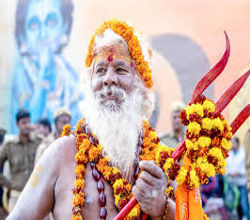Why Naga Babas Do Not Wear Clothes. Naga Babas, also known as Naga Sadhus, are a distinct group of ascetic monks in India. They are revered for their spiritual practices and commitment to renouncing worldly possessions, including clothing. The question arises, why do Naga Babas choose to live without clothes? Let’s explore the spiritual, cultural, and historical aspects behind this unique practice.
Why Naga Babas Do Not Wear Clothes
Spiritual Significance
- Detachment from Material Possessions
- One of the core philosophies of Naga Babas is the idea of renunciation and detachment from worldly possessions. By choosing to go unclothed, they aim to free themselves from the attachment to physical comfort and societal norms.
- Sacrifice and Simplicity
- Naga Babas believe that by shedding clothes, they can embrace simplicity. The human body, without garments, symbolizes purity and a focus on the spiritual path rather than physical appearances or material comforts.
- Spiritual Liberation
- Clothing is seen as a barrier to enlightenment. Without clothes, they believe it helps in achieving greater spiritual liberation and oneness with the universe.
Cultural and Historical Context
- Ancient Tradition
- The practice of asceticism dates back thousands of years in India. Naga Babas are part of this ancient tradition where individuals renounce societal norms to pursue a higher level of spiritual understanding.
- Sadhus’ Lifestyle
- They follow the lifestyle of a Sadhu, which means a holy person who has detached themselves from worldly desires. This includes living a simple life, often wandering in forests, hills, and ancient temples, without possessions, including clothes.
- Sacred Festivals and Rituals
- During religious festivals like Kumbh Mela, They are highly revered. Their nakedness is not seen as a lack of modesty but as a way of expressing their spiritual devotion and commitment to higher ideals.
Symbolism Behind Nudity
- Freedom and Equality
- Nudity among Naga Babas is symbolic of freedom from societal classifications like gender, caste, and status. In their eyes, everyone is equal in the eyes of the divine.
- Acceptance of Body as a Temple
- Naga Babas see their bodies as a temple. By going unclothed, they eliminate material attachments and focus on maintaining purity and spirituality.
- Practice of Asceticism
- Asceticism is deeply rooted in Indian spirituality, where individuals reject materialistic desires to pursue higher states of consciousness. Clothing represents attachment and distraction from spiritual goals.
Naga Babas Today
- Modern-Day Sadhus
- While the tradition of Naga Babas has been preserved for centuries, some modern Naga Babas may wear minimal clothing, often in colder regions or when traveling through urban areas. However, their primary lifestyle still revolves around renunciation and spiritual practices.
- Spiritual Activism
- Naga Babas are known for their activism for social causes. Whether it’s opposing injustice or promoting social harmony, they are often seen as guardians of ancient values and wisdom.
Lifestyle and Challenges
They live a unique and nomadic lifestyle, often moving from one pilgrimage site to another. Their journey involves living in ashrams, temples, or secluded places, where they dedicate their time to meditation, prayer, and performing rituals. Their simplicity and focus on inner peace contrast sharply with the materialism prevalent in today’s world.
Despite their spiritual purpose, Naga Babas face various challenges, including harsh weather conditions, physical discomfort, and sometimes social discrimination. Their lifestyle is not widely understood by the general public, leading to misunderstandings and misconceptions. However, their resilience and unwavering commitment to their spiritual path serve as an inspiration to many.
In recent years, the younger generation of Naga Babas is incorporating social media and modern communication tools to spread awareness about their practices and values. While they maintain their traditional ways, they adapt to contemporary platforms to reach a broader audience.
Through their unwavering dedication and spiritual practices, Naga Babas continue to preserve ancient Indian spiritual traditions and contribute to the spiritual fabric of society.
Also Read – Scientifically Proven Tricks That Can Make You Attractive
Conclusion
The practice of Naga Babas not wearing clothes is deeply embedded in India’s spiritual heritage. It represents a profound commitment to simplicity, renunciation, and spiritual enlightenment. For them, clothing symbolizes worldly attachments that can hinder the path to self-realization. In modern society, their unique lifestyle continues to attract attention and respect for its dedication to higher spiritual ideals.



